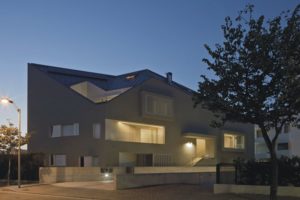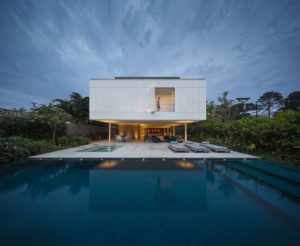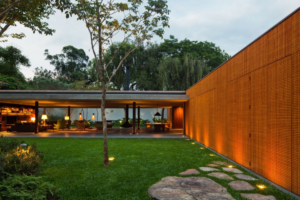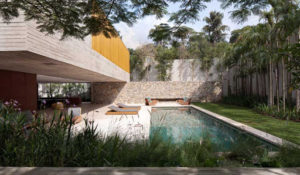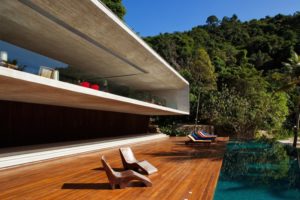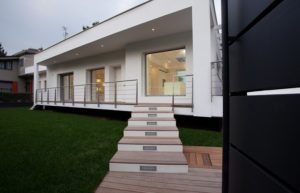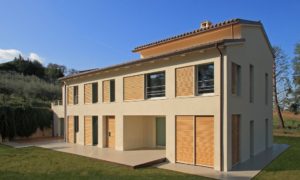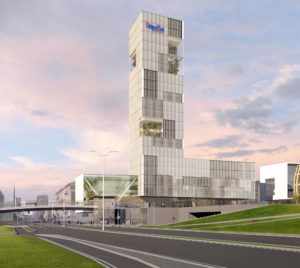Il progetto, nella zona residenziale di Jesolo, prevede la realizzazione di un edificio con cinque appartamenti distribuiti su tre piani. Caratteristica principale del fabbricato sono gli accessi indipendenti dei vari alloggi. Un “abitare collettivo” dove, in realtà, quasi non esistono spazi comuni tra i residenti.
La pianta ad U in corrispondenza della scala centrale, che conduce all’unica abitazione al terzo piano, sviluppa una rotazione dell’ala sud che diminuisce gradualmente verso l’esterno. A piano terra si trovano due appartamenti con i relativi giardini privati mentre gli alloggi del secondo piano sono raggiungibili da una scala esterna posta nel lato est dell’edificio.
La chiarezza volumetrica è interrotta da logge rientranti che proteggono l’ambiente intimo degli appartamenti contribuendo a realizzare degli spazi di relazione tra interno ed esterno. Nel prospetto questi vuoti, intervallati da griglie di mattoni, sono evidenziati da un colore più scuro rispetto alla tonalità bianca dell’intonaco. Ad identificare i prospetti, le falde inclinate in zinco-titanio della copertura che “invadono” le facciate spezzandone la linearità.
Comfort and building maintenance throughout the years are two fundamental aspects for houses built in tropical areas next to the sea, where the high temperatures and the effect of the sea air determine the extreme local conditions. The White House project, located on a beautiful Brazilian beach, on the northern coast of São Paulo, made these questions as determinant to organize the plan and for the selection of materials to be used.
All of the ambients have floor-ceiling window frames – in the spans, like true walls of sliding glass – to create a pleasant thermal sensation and blur the division between interior and exterior. In the living room on the ground floor, for example, 3.0 X 2.5 glass doors are built into the walls and integrate the indoor space with the balcony,,in this way creating cross ventilation with the aim of reducing the room temperature. In this same space, wooden perforated doors – like large muxarabis – shade the interior without blocking the breeze.
On the ground floor we find the entire social area of the house, even the kitchen which faces one of the side gardens. The first floor, in turn, houses the bedrooms. And lastly, there is a terrace garden with deck on the roof – accessible by a flight of stairs protected by a hatch door.
Warm materials are meshed into the metal brises, shading the room on the upper volume. The combination of the wood, concrete and white aluminum (resistant to the effects of the sea air) end up creating, in the architecture of this house a tropical minimalism, with great influence of Brazilian modernism.
With the façade radically horizontal, the Lee House is organized in a single volume ground-floor site. All of the rooms therefore, establish a strong relationship with the external, opening out to the garden. The spatial continuity with the living room is larger: all of the windows are recessed creating an extension of the external space, with a large veranda. The living room then prolongs the pool deck and crosses to the other side of the lot. These solutions are fit for the climate, the interior of the State of São Paulo, in the Brazilian southeast, which has elevated temperatures almost every day of the year. Strategies of traditional ambiental comfort of vernacular architecture and even Brazilian modern was used. The living room has cross-ventilation, which greatly lowers the internal temperature and the other rooms are protected by wooden muxarabis panels placed on sliding doors which filter the Sun without removing the ventilation. The front veranda is delimited by a foyer in the façade revealing two wooden boxes divided by the social area. The kitchen opens to the living room, encrusted in one of the boxes that hold the utility areas. The bar opens out to the social area and is contained in the box that holds the bedroom as well. At the end of the corridor of the bedrooms, which can also be accessed from the outside of the house, there is a spa delimited by external walls and composed by a gym room, a sauna and a small outdoor pool encircled by the deck. Besides the wood of the wooden boxes, the house is clad by White mortar and the internal patio of the spa is encircled by stones. The few materials used by the Lee house and the simple organization of the program create a minimalist atmosphere that extends from the outer to the inner areas of the house.
An urban house resting like a monolith over the garden; a single cubic volume housing every function and opening and closing to the outside. Each design has small, very simple rules that give the structure its form. The rule here was to inhabit this pure volume, building openings wherever necessary and considering climate conditions. The common area is therefore an open space, like a rip in a concrete box, totally integrated with the garden. The cube-box is rebuilt on this floor using metallic panels – made of perforated sheets – that can be opened all the way. When closed, this system gives the room privacy and shade. When open, indoor space becomes an extension of outdoor space. The other top two floors are held in a concrete box, where the project’s rules, the perforations in the cube, are continued: there are open windows in the bedrooms, television room and office, providing ventilation. Nevertheless, the cube’s materiality remains clearly identifiable. On openings in the bedrooms, the same metallic paneling works to filter the light. A second layer for closing is made of sliding glass panels. This entire system of metal and glass panels is completely embedded in the walls, giving the homeowners total control of lighting and ventilation. The last floor houses not only part of the home’s infrastructure, but also a small outdoor living area on a garden terrace, with a view to the surrounding area. Like its simple volumes, Casa Cubo uses few architectural materials. The façades are comprised of rough concrete – shaped using a handcrafted wooden mold – and the metallic panels – whose color is reminiscent of the concrete itself. The inside is structured by a specially designed ceramic tile floor that forms a continuous fabric in the common area. Casa Cubo at night becomes a lantern. The internal space is seen on the façade: the dense volume of concrete is muted, giving way to volumes of internal light, as if they were extruded from the cube itself. A monolithic volume that, in its empty interior, contains other volumes.
With each new project contemporary architecture is forced to optimize spaces and use the maximum of each square meter of the site. V4 House is a rare anti-example. Its occupation of the land is very far from the maximum coefficient. Laws allow for much larger constructions. The solution adopted, however, dialogues with the dimension of the site, formulating an adequate relation between the scale of the construction and the site. Contrary to the surrounding houses, a garden neighborhood of São Paulo, V4 House is a ground floor and almost disappears when seen from the street. The living room, positioned at the front of the house, is under a delicate beam of exposed concrete. Two rows of door frames, on both sides of the living room, can be completely retracted, constituting total integration between the front garden, the living room and the back patio. The living room, in this case, shelters from rain and sun, like a large veranda. And, under the beam, in one of the extremities, there is an open kitchen. On the ceiling of this volume, a large deck is an empty space that functions as a solarium. This terrace makes almost the entire project like a garden. The concrete beam appearing from the wooden box, houses the two rooms that face the patio. In the wooden box from where the concrete beam appears, are the two rooms that face the patio. The wooded shaded area enables to control the inner temperature and, simultaneously, offers privacy to the environments. The bathroom of the master bathroom faces a small garden, removed from the rest of the house. The program for the client’s needs and the dimensions of the site made it possible to do an unusual project: an urban ground-floor house. The house ends up, therefore, being very delicately inserted with the surroundings.
en years ago, when StudioMK27 tried to do a project using exposed concrete, many builders said that this was practically impossible. Yeah, Right – Brazil that has a vast modern tradition in the use of raw concrete? During a determinate period, in the 90´s, the use of the material declined sharply, restricted to the few architects that used it experimentally e sporadically, without fixing a constructive know-how. Concrete is, on the other hand, a type of x-ray of the construction and of the passing of time, where the surface is impregnated not only with the smallest defects but also the knots of the wood. It is liquid stone, as has already been said. The experience of constructing in raw concrete during these last ten years has shown StudioMK27 the impracticality of making an absolutely perfect material. The House of Ipês incorporates this experience of design and construction in exposed concrete. In this house the material is used in a radical manner throughout the upper volume and, as such, the large concrete Box appears to be floating atop a glass volume. In the living room, which continues to the veranda and the garden, the doors open entirely, diluting the division between interior and exterior. The main entrance is done through pivoting panels that also open entirely to the front garden. In the internal space, a long irregularly-shaped sofa wriggles around the room, constructing a space with no hierarchy among the different orientations. On the top floor, a TV room distributes the circulation to the bedrooms, which are lit by a wood block on the concrete wall of the facade. The wooden brises offer the interior great thermal comfort and makes it possible to totally control the lighting. The structure of the house incorporates large spans which accentuate the Idea of a floating Box, besides propitiating a totally free and continuous space. The use of raw concrete refers to modern buildings, aesthetically and functionally, as in a dialogue with this modern architecture. The House of Ipês, with its grand spans and brute material, transpires a sobriety and the concrete impregnated by the passage of time, exposes the existence of the life of the building.
La Paraty House di Marcio Kogan e Suzana Glogowski si presenta come un volume composto da due scatole di cemento armato ancorate al fianco della montagna di un’isola brasiliana. Due prismi moderni tra gli enormi massi del litorale. I volumi del progetto, esterni alla montagna, sono posti quasi all’altezza della spiaggia, a sbalzo su di essa per 8 metri. La casa, con abilità strutturale, trova equilibrio nella topografia del terreno, e costituisce una sorta di accesso aperto e ampio a una natura praticamente incontaminata. Fra le rocce di Paraty, nella fitta foresta pluviale dell’isola, si scopre questo volume ortogonale che penetra nel verde e da cui si ha subito accesso al cuore della casa che ospita un’importante collezione di mobili del XX secolo progettati, tra gli altri, da George Nakashima, Luis Barragan, Lina Bo Bardi, Sérgio Rodrigues, Joaquim Tenreiro e Zanine José Caldas. Gli abitanti arrivano solo in barca: l’ingresso della casa, a cui sia accede dopo aver attraversato la spiaggia, avviene tramite un ponte metallico che, passando al di sopra di una piscina in cristallo, conduce alle scale che collegano al volume più basso in cui vi sono soggiorno, cucina e servizi. Questo spazio continuo interno ha una lunghezza di 27 metri ed enormi vetrate per permettere la vista-mare. Le stesse scale conducono al volume superiore che ospita le camere da letto. Nella parte anteriore della casa, pannelli retrattili di rami di eucalipto proteggono le stanze dal sole. Gli spazi che si affacciano verso il monte hanno piccoli patii interni con illuminazione zenitale e calcestruzzo a vista trattato con una particolare texture. Tutta la parte superiore della casa è coperta da terrazze, osservatori per gli abitanti, o da giardini per le sculture e per le piante medicinali e le erbe commestibili.
Una ristrutturazione lineare dalle linee pulite e dall’anima funzionale ed ecologica. BIANCO CUBO è un intervento di riqualificazione e ristrutturazione che si ispira all’architettura moderna europea. Grande attenzione è stata rivolta all’utilizzo di materiali innovativi e nuove tecnologie ecosostenibili.
Località: Loreto
Cronologia di progetto:
2008 progetto
2008 – 2009 realizzazione
L’edificio è concepito come completamento di piazza Gae Aulenti, in zona Porta Nuova a Milano. L’edificio è composto dalla sovrapposizione di due nastri, il primo segue l’andamento della piazza, il secondo si muove verso l’alto. Il corpo basso riprende l’allineamento degli edifici circostanti e piega orientandosi sull’asse viario principale. La variazione nel ritmo degli elementi verticali della facciata crea differenti livelli di permeabilità. Le corti verdi, insieme alla piazza verde / giardino botanico, migliorano il comfort e la vivibilità degli spazi interni e dei luoghi di lavoro, contribuendo al benessere bioclimatico.
Concorso ad inviti
Milano, Italia
2015
Committente: UnipolSai
Superficie costruita: 15.000 mq
